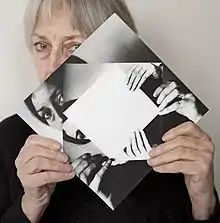Dora Maurer
Dóra Maurer (born 1937 in Budapest) is a Hungarian visual artist whose work has spanned a 50-year career.[1] She works in almost every medium, from film and photography, to painting, performance, and sculpture. [2] Principally achieving recognition in the 1970s with avant-garde work, Maurer has developed her art career from works with contemporary and modern influences that have been shown worldwide. Her art is based on mathematical and complex system processes. Most of Maurer's work follows the theme of showing options to the viewer and what the viewer can do with those options. Many of her works break down simple actions so the viewer can really view the piece as movement, not a photograph of movement. Dóra Maurer has in addition been a professor at the Faculty of Fine Arts in Budapest[3] and a curator.
Dóra Maurer | |
|---|---|
 Dóra Maurer Self-Portrait with Seven Twists | |
| Born | 1937 Budapest |
| Nationality | Hungarian |
| Known for | Visual Art |
| Website | https://doramaurer.com/ |
Life
Maurer trained as a graphic artist in the 1950s.[4] In the 1970s she started to work in photography and moving images, often collaborating with musicians. She also taught creative performative workshops. She created increasingly geometric and abstract drawings and paintings in the 1970s onwards.[4]
In 2019 to 2020, she was the subject of a major retrospective exhibition at the Tate Modern.[4] White Cube Gallery began to represent Maurer in 2019.[5]
Works
In Dóra Maurer's work, geometric, mathematical, and conceptual[6] systems all appear. These are the processes in which her mind thinks when creating her art. Dóra Maurer explores different cycles in showing things such as simple actions to make the viewer see her art as movement. She simply gives the viewer examples of things she can do with different objects, to make them think about what they would do. All of Maurer's work displays geometric compositions and designs. She is very methodical with the composition she uses, the images, lines, width of lines, colors, angles, and more. Some of her best known works come from her quasi-photos, her series Reversible and Changeable Phases of Movement, and her most recent series, Overlappings.
While Dóra Maurer states that her works are simple examples of what she can do, many critics like to attach political undertones to them. In the past, people have said that her works are examples of the socialist background in which she grew up. It is important to note, however, that Dóra Maurer does not consider her art political, nor does she bear the thought in mind when creating. In fact, Maurer has said that the only reason people say her work is political, is because everything made during that time was political.[7] Most of this critique is attributed to her work done in the 1960s to 1980s.
Maurer began to develop surreal etchings in 1961, exploring the technical possibilities of the medium. In 1969/1970 she began to create time-based works that time and space and energy have on an event. In the experimental film Timing (1973-1980) she folds a white cloth against a black background, making it as small as possible, in a total of seven steps. As the image itself is halved, then divided in four and finally in eight, and the steps in the folding process are played at the same time, the white surfaces of the cloth merge in some places, resulting in one image. [8]
Exhibitions
Since 2007
- Tate Modern - 5 August 2019 - 5 July 2020[4]
- White Cube Bermondsey, 12 September 2019–3 November 2019[9]
- White Cube Masons Yard, 24 May 2016–9 July 2016 [10]
- Museum Ritter - Snapshots, 18 October 2014–19 April 2015
- Petr Vesely - NOTHING, 6 December 2011–12 February 2012
- StartPoint, 12 October 2011–4 December 2011
- Michal Cernusak, 21 June 2011–25 September 2011
- Pavel Hayel, 22 June 2010–10 October 2010
- Esther Stocker, 14 April 2010–6 June 2010
- Erik Sille, 19 February 2010–11 April 2010
- Lukas Jasansky/Martin Polak-Jan Merta, 25 September 2009–31 January 2010
- Christian Stock/A/, 24 April 2009–30 August 2009
- Jiri Mateju, 5 February 2009–5 April 2009
- Tomass Hiavina, 28 November 2008–1 February 2009
- Adam Szentpetery, 19 September 2008–?
- Barbara Holler-SYSTEMS, 18 April 2008–29 June 2008
- Jifi David, 21 September 2007–?
- Zakazane Uvoineni, 4 May 2007–2 September 2007
- PitoreSKa, 24 January 2007–22 April 2007
References
- "Dora Maurer". Artinfo. Retrieved 28 April 2012.
- https://www.theguardian.com/artanddesign/2019/aug/11/dora-maurer-review-tate-modern
- Wannieck Gallery. "Dora Maurer". Wannieck Gallery. Retrieved 28 April 2012.
- Tate. "Dóra Maurer – Exhibition at Tate Modern". Tate. Retrieved 2020-02-28.
- Shaw, Annie (September 5, 2019). "Dora Maurer: 'a lack of market was positive for my work'". www.theartnewspaper.com. Retrieved 2020-04-07.
- Balvanyos, Anna. "Dora Maurer". E-Flux. Retrieved 28 April 2012.
- Rappolt, Mark. "Dora Maurer". Art Review. Retrieved 28 April 2012.
- Radical Women Artists behind the Iron Curtain. ISBN 978-3-96098-527-3.
- "White Cube - Dora Maurer Bermondsey 2019". whitecube.com. Retrieved 2020-02-28.
- "White Cube - Dora Maurer Masons Yard 2016". whitecube.com. Retrieved 2020-02-28.
